Andromeda Galaxy

The Andromeda constellation - the place in which the Andromeda Galaxy is located.
The Andromeda Galaxy (also known as Messier Object 31, M31, or NGC 224; older texts often call it the Andromeda Nebula) is a giant spiral galaxy in the Local Group, together with the Milky Way galaxy. It is at a distance of approximately 2.9 million light years or 900 kpc, in the direction of the constellation Andromeda.With a mass of about 1.5 times more than the Milky Way, it is the dominant galaxy of the Local Group, which consists of about 30 small galaxies plus three large spirals: Andromeda, Milky Way and M33. (With improving measurements and data, some scientists now believe that the Milky Way contains more 'dark matter' and may be more massive than M31.)
General information
Projections indicate that the Andromeda Galaxy is on a collision course with the Milky Way, approaching at a speed of about 140 kilometres per second. Impact is predicted in about 3 billion years; the two galaxies will probably merge to form a giant elliptical.
This galaxy plays an important role in galactic studies, since it is the nearest giant spiral. In 1943, Walter Baade was the first person to resolve stars in the central region of the Andromeda Galaxy. Edwin Hubble identified extragalactic cepheid variable stars for the first time on astronomical photos of this galaxy, enabling its distance to be determined.
Robin Barnard of the Open University has detected 10 X-ray sources in the Andromeda Galaxy, published April 5th 2004, using observations from the European Space Agency XMM-Newton orbiting observatory. He hypothesizes that these are candidate black holes or neutron stars, which are heating incoming gas to millions of kelvins and emitting X-rays. The spectrum of the neutron stars is the same as the hypothesized black holes, but can be distinguished by their masses.
In 1991 the Planetary Camera then onboard the Hubble Space Telescope imaged Andromeda's core. To everyone's surprise its nucleus showed a double structure, with two nuclear hot-spots located within a few light years of each other. Subsequent ground-based observations have led to speculation that indeed two nuclei exist, are moving with respect to each other, that one nucleus is slowly tidally disrupting the other, and that one nucleus may be the remains of smaller galaxy "eaten" by M31. The nuclei of many galaxies, including M31, are known to be quite violent places, and the existence of supermassive black holes are frequently postulated to explain them.
Scott Chapman, from the California Institute of Technology, and Rodrigo Ibata, from the Observatoire Astronomique de Strasbourg in France, announced in 2005 their observations with the Keck telescopes which show that the tenuous sprinkle of stars extending outward from the galaxy are actually part of the main disk itself. This means that the spiral disk of stars in Andromeda is three times larger in diameter than previously estimated. This constitutes evidence that there is a vast, extended stellar disk that makes the galaxy more than 220,000 light-years in diameter. Previously, estimates of Andromeda's size ranged from 70,000 to 120,000 light-years across.
Observation
The Andromeda Galaxy was observed in 964 by the persian astronomer 'Abd Al-Rahman Al Sufi, who described it as a "small cloud". The first description of the object based on telescopic observation was given by Simon Marius (1612), who is often wrongly credited as the discoverer of the Andromeda Galaxy.
In 1885, a supernova (known as "S Andromedae") was seen in the Andromeda Galaxy, the first and so far only one observed in that galaxy.
The Andromeda Galaxy is easily visible to the naked eye in a truly dark sky; however, such a truly dark sky is available only in relatively few, isolated areas very far from population centers and sources of light pollution. It appears quite small to the eye because only the central part is bright enough to be visible, but the full angular diameter of the galaxy is seven times that of the full moon.
In the News ...
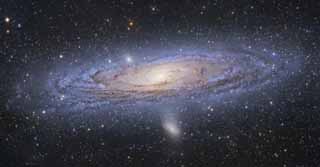
Andromeda Island Universe NASA - January 24, 2008
Astronomers discover an enormous halo of red giant stars around Andromeda BBC - January 8, 2007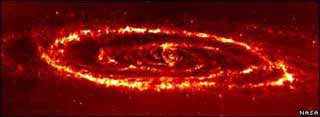
Collision Created Rings Around Andromeda Space.com - October 18, 2006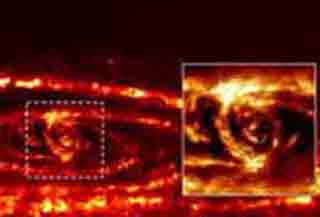
Lady in Red: Andromeda Galaxy Shines in Spitzer's Eyes PhysOrg - October 14, 2005
Mysterious Stars Surround Andromeda's Black Hole Space.com - September 21, 2005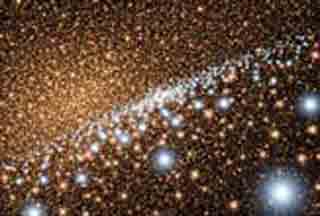
Mysterious ring of stars guards Andromeda's heart New Scientist - September 21, 2005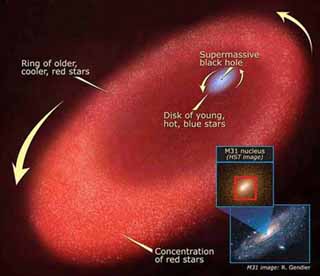
Andromeda Galaxy just got three times bigger Space.com - May 31, 2005
The Andromeda galaxy is a spiral galaxy similar to our own Milky Way. Although there are smaller dwarf galaxies nearer to us, Andromeda is the closest large galaxy - at about 2 million light-years from Earth.
New Evidence of Cannibalism in Andromeda Space.com - April 2004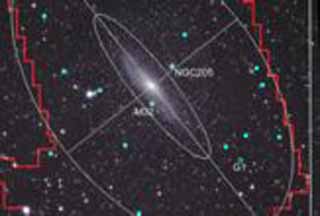
The giant spiral is consuming a previously known satellite galaxy
Andromeda Constellation
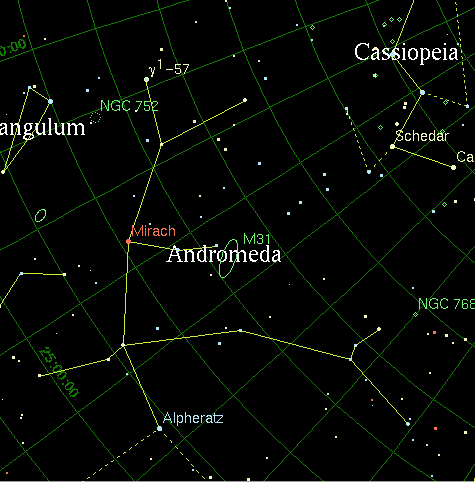
Andromeda is a constellation named for the princess Andromeda (which is Greek for Ruler over men), a character in greek mythology. The constellation is in the northern sky near the constellation Pegasus, and takes the general shape of a long, dim, straggly letter "A". It is most notable for containing the Andromeda Galaxy.
This large constellation of the northern hemisphere belongs to the constellation family of Perseus. The name of the alpha star of Andromeda Sirrah (or Alpheratz) has been taken form the Arabic meaning "horse's navel". The reason for this is because in former times this star has been associated with the constellation of Pegasus, next to Andromeda. Nowadays it marks the head of the royal daughter. Sirrah is a blue-white star (spectraltype B8IVpMnHg) with mag 2.06.
Mythology
If fainter stars, visible to the naked eye, in the constellation are considered, then the constellation takes the form of a female stick-figure, with a prominent belt (as has the constellation Orion), where one arm has something long attached to it, giving the appearance of a female warrior holding a sword. This, together with other stars in the zodiac sign of Aries (part of Pisces, and the Pleiades), may be the origin of the myth of the girdle of Hippolyte, which forms part of The Twelve Labors of Heracles.
Alternately, by including still fainter stars, which the naked eye can see, the attachment extends in a different direction, giving the appearance of a maiden held by a chain., and Andromeda appears to be trying to get away. Together with other constellations nearby (Cepheus (constellation), Perseus, Cassiopeia, and possibly Pegasus), and the constellation Cetus below Andromeda, this may be the source of the myth of the Boast of Cassiopeia, with which it is usually identified.
Stars and other objects
The binary gamma And gives splendid view even in smaller telescopes for the two components can easily be separated. The brighter component has mag 2.2 whereas the fainter shows a brightness of mag 5.0 . As they are of different color they certainly make a showpiece of a double in the sky.
The 56 And. is a fainter pair, both being of 6th magnitude.
The planetary nebula NGC 7662 is one of the easiest to view with smaller amateur instruments. Using a high magnification it reveals a fuzzy blue-green elliptical disk.
The stars of the open star cluster NGC 752 are scattered over a large area. Therefore it is best viewed with binoculars. The member stars (about 100) show magnitudes between 9 and 10. NGC 752 is located near 56 And.
This constellation is best known for the Andromeda Galaxy, M31, one of the most famous objects in the sky, which can most easily be found (it can be seen even with the naked eye once you get a bit out of a lightpolluted city) and gives a brilliant view in each optical instrument. As it is the nearest spiral galaxy to us, it allows therefore an intensive study of the properties of spiral galaxies. Because we sit within our galaxy we cannot so easily observe the properties of ours but the Andromeda galaxy helps to understand our galaxy as well.
The Andromeda Galaxy has two satellites: M110 (NGC 205) and M32. M110 is located one degree northwest of M31 and M32 can be found half a degree south of M31. Both are elliptical galaxies. Detailed information to all three galaxies can be found in the Messier database about M 31, M 32 and M110.
Greek Mythology
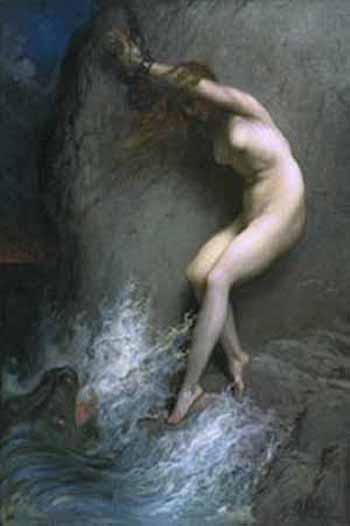
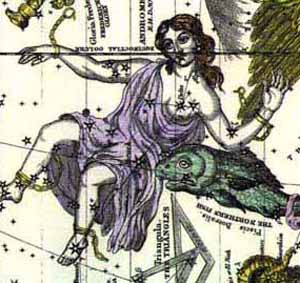
In Greek mythology, Andromeda was the daughter of Cepheus and Cassiopeia, king and queen of Ethiopia.
Cassiopeia bragged that she was more beautiful than the Nereids (water-nymphs), and so in revenge, Poseidon sent a flood and a sea monster to plague the land. Cepheus then consulted the oracle of Ammon, and was told that he had to sacrifice his daughter to the sea monster in order for the problem to end. His people forced him to comply with the oracle, and he chained Andromeda to a rock by the sea. She was rescued by Perseus who killed the monster who then married Andromeda. One of their children, Perses, became the ancestor of the kings of Persia.
Andromeda is Greek for "ruler of men". She is represented in the northern sky by the constellation Andromeda which contains the Andromeda Galaxy.
No comments:
Post a Comment